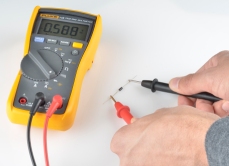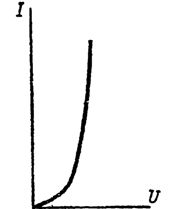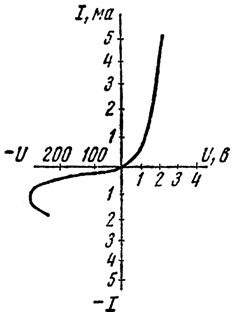Current-voltage characteristics of semiconductors

Current-Voltage Characteristic (VAC) — the dependence of the current flowing through the resistance on the voltage across this resistance, expressed graphically. I — V characteristics can be linear and non-linear, and depending on this resistance, and circuits containing these resistances are divided into linear and non-linear.
So, the volt-ampere characteristic is the dependence of the electric voltage on the strength of the current in the electric circuit or its individual elements (rheostat, capacitor, etc.). The voltage-current characteristic of linear elements of an electrical circuit is a straight line.
With an increase in the voltage applied to the semiconductor, the value of the current in it increases much faster than the voltage (Fig. 1), i.e. there is a non-linear relationship between current and voltage. If, when the voltage U changes to the reverse (-U), the current change in the semiconductor has the same character, but in the opposite direction, then such a semiconductor has a symmetrical current-voltage characteristic.
V semiconductor rectifiers selection of semiconductors with different types of electrical conductivity (n-type and p-type) asymmetric volt-ampere characteristic (Fig. 2).
As a result, with one half-wave of the alternating voltage, the semiconductor rectifier will pass current. It is a forward current Ipr that rapidly increases as the first half-wave of the ac voltage increases.
When exposed to the second half-wave of voltage, the system of two semiconductors (in a flat rectifier) does not pass current in the opposite direction Iobr. A very small amount of current Irev flows through the pn junction due to the presence of minority carriers in semiconductors (electrons in a p-type semiconductor and holes in an n-type semiconductor). The reason for this is the high resistance of the junction layer (pn junction) occurring between the p-type semiconductor and the n-type semiconductor.
As the second half-wave of the alternating voltage is further increased, the reverse current Iobr will begin to slowly increase and may reach values where the barrier layer (pn junction) breaks down.

Rice. 1. Current-voltage characteristic of a semiconductor
Rice. 2. Asymmetric volt-ampere characteristic of a semiconductor rectifier (flat diode)
The higher the ratio of direct current to reverse current (measured at the same voltage values), the better the rectifier's properties. This is calculated from the value of the correction coefficient, which is the ratio of the forward current I'pr to the reverse I'obr at the same voltage value:


